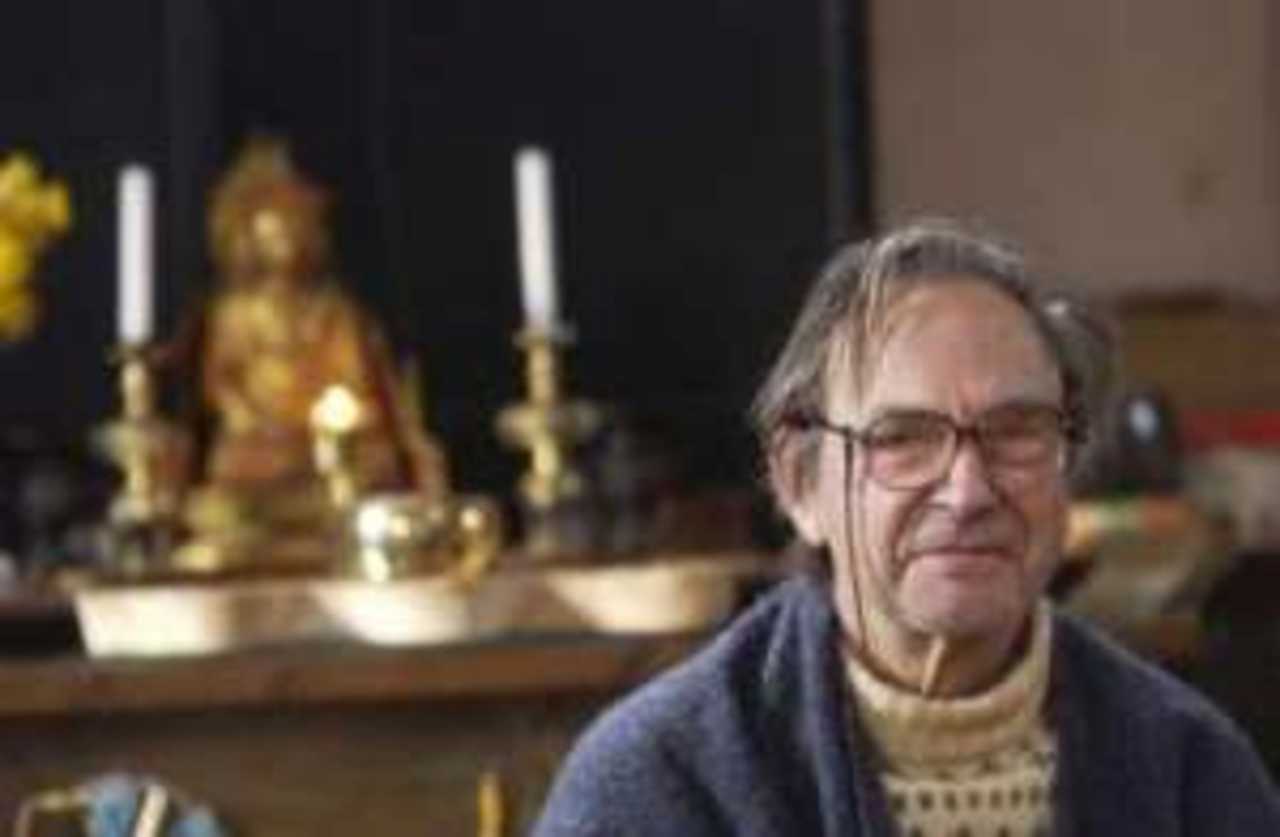Opening The Treasure House
from the "Sermons to the Stones and Trees" tapes, Summer 1991
"If you do these things for some time the treasure house will open naturally and you will enjoy it fully." These are the concluding words of a Soto Zen ritual. Remember: "The treasure house will open naturally."
In meditation, it is not that one has to work desperately hard to get somewhere. The practice of meditation should be something like breathing, or walking, something natural. If there is too much strain, too much tension, meditation becomes egoistic. It becomes a form of desire, a form of need. That is why the basic element in the practice of meditation involves a deep relaxation; the use of the breath or of repeating a mantra - allowing the mind to cool down. These things, are not meditation in itself, they are preliminaries. They are the ways of bringing the mind to a quieter space in which meditation can happen of its own accord. When one sits down and faces the wall, the first thing to do is to check out where the mind is. Sometimes it is very quiet and you can just listen to the bird song, but more usually the mind is full of stray energy, darting this way and that. As one practitioner put it to me "The hunting dogs are out, restlessly searching, restlessly chasing." It's not always clear what they are hunting. The wants of the ego in its need for comfort, its need for security, its need for self- validation or validation by another all generate the chase. We want the support of credentials, the support that comes from others telling us that everything is alright. There is the endless need for a little bit of love. The restlessness of the free-running ego is like a car idling, continually turning out low-toned noise. This is the restlessness of the needy ego - the basic suffering.
When you sit, the first thing to do is to find out where the mind is. Just to recognise it is the thing. Just to notice the irritation of the approaching aeroplane, this unwanted intrusion by some pilot in the sky. Just to recognise the way in which the mind is disturbed, thrown off centre. And in such recognition often comes a realisation. Simply knowing where the mind is will often do it. "Yes" you might say "Yes, that's where it is. That's what I'm on about." First thing then - check out where the mind is.
The second thing to do is to open the mind to the universe. The universe is right in front of you. Just open yourself to the sounds in the room where you are sitting, to the white wall, to your own body, to the friends with whom you are meditating. All of that is the universe. What else could it be!
All of it is here right now as one experience. Can you relate to it? Can you open the heart so that the experience of yourself as Just Being comes quietly upon you - no big deal?
Dogen, the great Japanese teacher who brought Soto Zen from China to Japan, speaks of the three activities in Zazen: thinking; not thinking; and without either thinking or not thinking. When the mind begins to sit, it rehearses the past or perhaps the hopes for the future. It is a patterning of hopes and fears that constitutes thought. And when you say to yourself " Oh, I should be meditating, I should not be thinking, I should not be worrying or hassling." That is the rejection of thought, the endeavour not to think that sets up its own problem. The practice of just sitting requires the simple allowing of what is on top to bubble forth.
When we sit down in meditation it is like taking the top off a bottle of beer, everything bubbles up and you need to note what the bubbles are saying. "Yes, that is that", "Yes, this is this. Yes that's so and so!" And then don't get stuck with it and work with it, let it drop! Let it go, and resume silence until something else comes up of its own accord. Not searching for it; not trying to work; so that if nothing particular comes up, you are just sitting. This practice is called "Without Thinking And Without Not Thinking!" It is just being, naturally. That is the natural way the unhassled mind works. Things crop up and things blow away.
Sitting in zazen requires three rather old fashioned attitudes The attitude of faith, the attitude of will, and an attitude which allows one to let go of any particular need for success. Faith is derived from knowing people who have found meditation to be of value. Faith is derived from knowing something about scripture, and having trust in the meditation manuals; faith comes from your knowledge. When sitting facing the wall the mind may be hassling and troubled. At such times remember there have been times, and there will again be times, when the great peace appears.
This faith allows one to have the willpower to sit. It is necessary to have the will to sit in order to counteract the sort of self-indulgence which says "Well, there's a nice television programme on, I'll watch that!" or, "I'll go for a walk in the bluebell wood, I can meditate another time". Will simply means a degree of confrontation with our comfort seeking self-indulgences. Faith and Will allow one to work without the driving force of great expectations.
It is important to learn that meditation does indeed yield the treasure house; that it opens naturally. You need a reward; you need the benefit of direct knowledge. That is why at first, one should be very simple and "work" hard. You need to experience the Great Peace, because, once the great peace has been even momentarily touched upon, your faith is then confirmed and the point of exerting will-power becomes clear.
I can tell you that when I first began training in meditation at Samye Ling Centre in Scotland, I was doing about five or six hour-long sessions in each day. And these were very agonizing, great mental struggles, a lot of physical discomfort. But it vanished with time. Some sessions were better then others. And then, on about the fifth day, I went for a walk. The wind was simply blowing though my head. The landscape began glowing as if made of green jade. These are mere words. Each of us has to try it out for ourself.
It is important to know that the unborn mind is lying there within you. The hassling mind is simply the movement of waves on the surface of the ocean. When the waves fall still, and the wind drops, the sea becomes clear. The process of meditation is one of allowing the waves to become quiet. The treasure house opens upon deep stillness. In that stillness there is no longer a wanting. There is depth. Nirvana means "Blown out." The mind has blown out all its wants and petty cravings. There is a deep silence as of a moonlit night over a windless ocean. And as you sit there in that great night, the meaning of the opening treasure house arises within you, a peculiar joy begins to appear. And it is that joy which is the beginning of meditation.
Homage to the Buddhas in all worlds.
Homage to the Bodhisattvas in all worlds.
Homage to the Scripture of Great Wisdom.
- Publication date:
- Modified date:
- Categories: 1991 Dharma Talks John Crook
-
 Western Chan Fellowship CIO
Western Chan Fellowship CIO - Link to this page
Back

©Western Chan Fellowship CIO 1997-2025. May not be quoted for commercial purposes. Anyone wishing to quote for non-commercial purposes may seek permission from the WCF Secretary.
The articles on this website have been submitted by various authors. The views expressed do not necessarily represent the views of the Western Chan Fellowship.
Permalink: https://w-c-f.org/Q372-128

